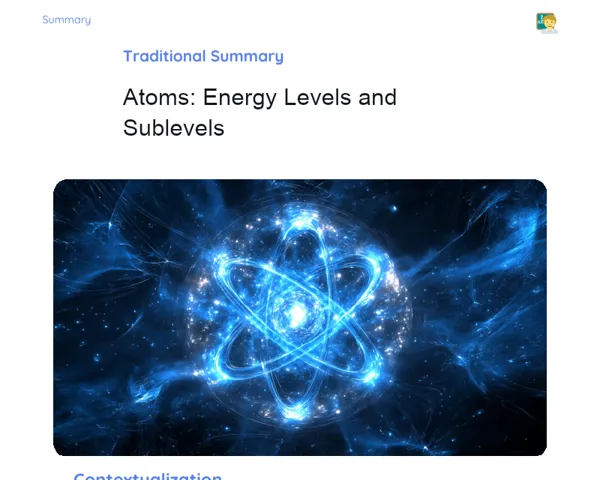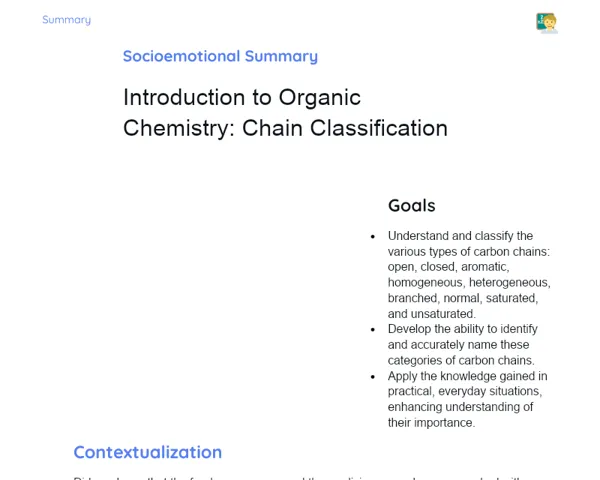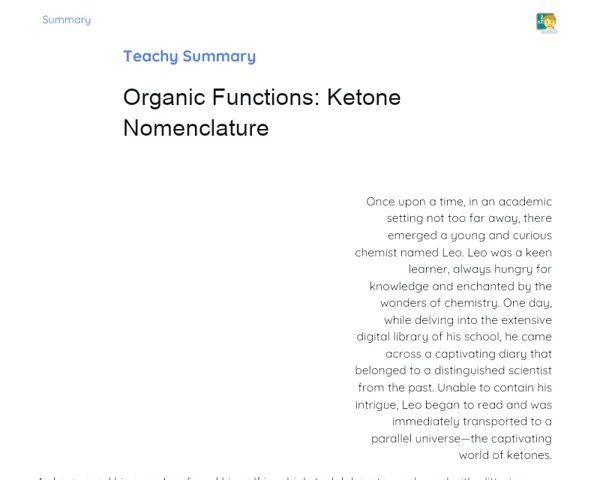Summary Tradisional | Organic Functions: Acyl Halide
Contextualization
Acyl halides form a significant class of compounds in organic chemistry, arising when the hydroxyl group (-OH) of a carboxylic acid is replaced by a halogen (like chlorine, bromine, or iodine). These compounds have a common structure represented as R-CO-X, where R denotes an alkyl or aryl group, and X signifies the halogen. Gaining a proper understanding of the structure and reactivity of acyl halides is vital for delving into numerous organic reactions and for synthesizing valuable compounds across diverse industries, particularly in pharmaceuticals and polymer production.
The high reactivity of acyl halides stems from the polarity of the carbon-halogen bond. This characteristic enables acyl halides to be involved in various chemical reactions, such as forming amides and esters, which are key processes in creating medicines and plastics. For instance, acetyl chloride, a specific acyl halide, plays a crucial role in producing acetylsalicylic acid (aspirin), one of the most widely used pain relievers. A sound grasp of these compounds bridges the gap between organic chemistry theory and its real-world applications that affect our daily lives.
To Remember!
Definition and Structure of Acyl Halides
Acyl halides are organic compounds obtained from carboxylic acids, where the hydroxyl group (-OH) from the carboxylic acid is substituted by a halogen (such as chlorine, bromine, or iodine). The general representation for acyl halides is R-CO-X, indicating that R is an alkyl or aryl radical, while X is the halogen. This substitution gives acyl halides a set of unique properties that set them apart from the original carboxylic acids.
The carbon-halogen (C-X) bond in acyl halides exhibits strong polarity, heightening their reactivity. This property arises due to the varied electronegativity between carbon and halogen, resulting in the carbonyl carbon being more prone to nucleophilic attacks. Such reactivity is a crucial aspect that enables acyl halides to engage in several significant chemical reactions.
Appreciating the structure and reactivity of acyl halides is essential for understanding organic reactions. These reactions encompass the formation of amides and esters, processes that are vital for synthesizing many useful industrial compounds, especially within pharmaceuticals and polymer production. Consequently, exploring acyl halides deepens students' theoretical knowledge while showcasing the practical relevance of these compounds in everyday scenarios.
-
Acyl halides are formed from carboxylic acids.
-
Their general structure can be expressed as R-CO-X, where R is either an alkyl or aryl radical and X represents a halogen.
-
The C-X bond's high polarity enhances the compound's reactivity.
Nomenclature of Acyl Halides
The nomenclature of acyl halides adheres to the conventions set by the International Union of Pure and Applied Chemistry (IUPAC). To name an acyl halide, one needs to pinpoint the acyl group (R-CO) along with the halogen substituent (X) present in the compound. Typically, the naming starts with the halogen's name, followed by the designation of the acyl group. For example, CH3COCl is referred to as acetyl chloride, where 'chloride' denotes the presence of chlorine and 'acetyl' pertains to the group CH3CO.
In instances where the radical R is an aromatic ring, such as benzene, the name of the acyl halide is derived from the associated carboxylic acid's name, substituting the '-ic' ending with '-oyl' and incorporating the halogen as a prefix. For instance, C6H5COCl is termed benzoyl chloride. This systematic naming approach helps in uniquely and transparently identifying each compound, facilitating effective scientific communication and the structured organization of chemical information.
Students need to get comfortable with these naming conventions to accurately identify and name acyl halides. This familiarity enhances theoretical understanding and is essential for practical laboratory work and for interpreting scientific literature, where precise nomenclature holds significant importance.
-
Nomenclature follows the IUPAC guidelines.
-
The naming initiates with the halogen followed by the acyl group.
-
For example, CH3COCl is referred to as acetyl chloride.
Physical and Chemical Properties of Acyl Halides
Acyl halides exhibit a range of physical and chemical characteristics that contribute to their unique and highly reactive nature. Their relatively elevated boiling points are notable, primarily due to the polarity of the carbon-halogen bond. However, acyl halides typically have low water solubility as they struggle to form robust hydrogen bonds with water molecules.
From a chemical standpoint, acyl halides are significantly reactive, driven by the polarity of the C-X bond. This reactivity becomes especially apparent during nucleophilic acyl substitution reactions, where the halogen (X) acts as a highly effective leaving group. Consequently, acyl halides take part in various reactions, such as forming amides when interacting with amines and creating esters in reactions with alcohols. These reactions are foundational for producing many organic compounds.
Additionally, acyl halides serve as intermediates in numerous chemical syntheses owing to their capability to introduce acyl groups into other molecules. This adaptability renders acyl halides crucial components in various industrial and laboratory processes, notably in the manufacture of medicines and plastic products.
-
High reactivity is attributed to the polarity of the C-X bond.
-
Acyl halides are involved in nucleophilic acyl substitution reactions.
-
These compounds function as intermediates in chemical syntheses.
Reactions with Acyl Halides
Acyl halides are well-acknowledged for their high reactivity in acylation reactions, wherein they incorporate the acyl group (R-CO) into other molecules. One prevalent reaction involves the formation of amides, which occurs when an acyl halide interacts with an amine. This entails a nucleophilic attack by the amine on the carbonyl carbon of the acyl halide, resulting in a tetrahedral intermediate that ultimately releases the halogen as a halide ion (X-) while forming the amide.
Another significant reaction is the ester formation that occurs when acyl halides react with alcohols. As with the amides, the alcohol functions as a nucleophile, targeting the carbonyl carbon of the acyl halide to yield a tetrahedral intermediate. The halide's elimination leads to the final ester product. These reactions are crucial for synthesizing a multitude of organic compounds, including various medicines and plastic materials.
The reaction pathways involving acyl halides are extensively investigated within the chemical industry due to their efficiency and versatility. For instance, synthesizing acetylsalicylic acid (aspirin) involves the reaction of acetyl chloride with salicylic acid, which efficiently produces acetylsalicylic acid. This approach is widely adopted because of its seamless execution and effectiveness in large-scale manufacturing.
-
Acyl halides form amides when reacted with amines.
-
Esters are formed through reactions with alcohols.
-
Reactions are widely studied within the chemical industry.
Key Terms
-
Acyl Halides: Compounds emerging from carboxylic acids, where the hydroxyl group is replaced by a halogen.
-
Acyl Group: A functional group denoted as R-CO, where R is either an alkyl or aryl radical.
-
Nucleophilic Acyl Substitution: Reactions whereby a nucleophile attacks the carbonyl carbon of an acyl halide, substituting the halogen.
-
Acetyl Chloride: A common type of acyl halide frequently employed in the manufacture of acetylsalicylic acid.
-
Reactivity: The inherent property of acyl halides that makes them readily reactive because of the polarity of the C-X bond.
Important Conclusions
Acyl halides are compounds derived from carboxylic acids, characterized by substituting the hydroxyl group with a halogen. Their general structure is represented as R-CO-X, where R signifies an alkyl or aryl radical, and X represents the halogen. This substitution renders acyl halides highly reactive, driven by the polarity of the carbon-halogen bond, which permits their involvement in key chemical reactions like the formation of amides and esters.
The nomenclature governing acyl halides aligns with IUPAC standards, ensuring the correct identification of the acyl group and the halogen substituent. This adherence is fundamental for scientific discourse and practice in laboratories. Furthermore, the distinctive physical and chemical characteristics of acyl halides, such as their reactivity and limited solubility, play a significant role in understanding their use in nucleophilic acyl substitution reactions and the synthesizing of various compounds.
The reactions involving acyl halides, including amide and ester formations, are extensively researched in the chemical industry. The manufacturing of medicines like aspirin underscores the practical implications of such compounds. Grasping the properties and reactions of acyl halides allows students to perceive organic chemistry as a practical science, with immediate relevance to both daily life and industry.
Study Tips
-
Revise the structure and nomenclature of acyl halides while practicing how to identify and name various compounds.
-
Focus on studying nucleophilic acyl substitution reactions involving acyl halides, emphasizing mechanisms and the resultant products.
-
Investigate the industrial uses of acyl halides in synthesizing medicines and polymers to enhance understanding of the theory-practice connection.



